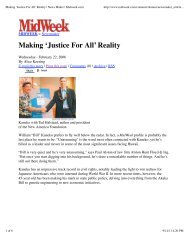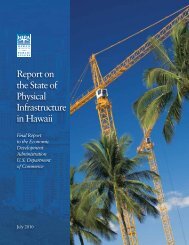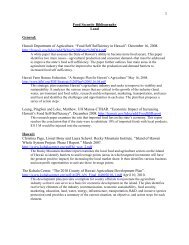Hawai'i Fisheries Initiative - The Hawaii Institute for Public Affairs
Hawai'i Fisheries Initiative - The Hawaii Institute for Public Affairs
Hawai'i Fisheries Initiative - The Hawaii Institute for Public Affairs
Create successful ePaper yourself
Turn your PDF publications into a flip-book with our unique Google optimized e-Paper software.
can give <strong>for</strong>mal testimony. If necessary, the<br />
rule is revised and submitted to BLNR <strong>for</strong><br />
final approval. It is reviewed again by the<br />
AG, and after signing by the governor and<br />
filing with the lieutenant governor, it has<br />
the effect of law.<br />
DLNR’s administrative rules relating to<br />
marine fishing are found under HAR Title<br />
13, Subtitle 4: <strong>Fisheries</strong>. 479 A system of<br />
Marine Protected Areas – which include<br />
Marine Life Conservation Districts, Fishery<br />
Management Areas, Fishery Replenishment<br />
Areas, Natural Area Reserves, and<br />
Bottomfish Restricted Areas – limit fishing<br />
ef<strong>for</strong>ts in <strong>Hawaii</strong>an waters <strong>for</strong> protection/<br />
conservation of marine life and habitat and<br />
replenishment of fisheries. An excellent<br />
map showing the various restricted areas<br />
is found at www.<strong>Hawaii</strong>.gov/dlnr/dar/<br />
images/MPAmaplg.jpg.<br />
u Marine Life Conservation Districts (Chapters<br />
28-38) – <strong>The</strong> most restrictive category of<br />
land-use zone, MLCDs are no-take zones<br />
(no harvesting). Other restrictions also<br />
apply. For example, in some MLCDs it<br />
is prohibited to fish, possess or destroy<br />
coral, possess fishing gear, or introduce<br />
any substances into the water to attract<br />
marine life. 480<br />
u Marine <strong>Fisheries</strong> Management Areas<br />
(Chapters 47-60.5) – Covering a broad<br />
range of territory and subject matter, these<br />
rules spell out habitat and catch provisions<br />
<strong>for</strong> areas such as Kahului Harbor on<br />
Maui 481 and the state marine refuge in the<br />
Northwestern <strong>Hawaii</strong>an Islands. 482<br />
u <strong>Fisheries</strong> Resource Management (Chapters<br />
49, 73-75, and 95) includes state deployment<br />
of Fish Aggregating Devices 483 (FADs are<br />
buoys that attract schools of tuna and other<br />
pelagic fish, such as mahimahi, and billfish,<br />
helping fishers to locate and catch these<br />
species); licensing and permit provisions;<br />
fees <strong>for</strong> fishing; and fishing gear 484<br />
u Protected Marine <strong>Fisheries</strong> Resources<br />
(Chapters 83-95) – Rules governing harvest<br />
of shellfish, Samoan crab, clams, spiny<br />
lobster, nehu (<strong>Hawaii</strong>an anchovy), corals,<br />
opihi (limpets), limu (seaweed), and<br />
bottomfish; and rules <strong>for</strong> taking and selling<br />
of certain other marine resources such as<br />
aquarium fish 485<br />
u Fishing License Requirements – Currently,<br />
recreational fishers in Hawai‘i are not<br />
required to be licensed. However,<br />
individuals or vessels engaged in taking,<br />
selling, or offering <strong>for</strong> sale any marine<br />
life <strong>for</strong> commercial purposes (including<br />
charter fishing services) 486 must obtain a<br />
Commercial Marine License from DAR.<br />
Commercial fishers are required to<br />
submit a monthly catch report. 487 License<br />
fees and other funds deposited into a<br />
Commercial <strong>Fisheries</strong> Special Fund within<br />
the state treasury are used <strong>for</strong> fisheriesrelated<br />
programs such as developing<br />
acceptable harvest levels, conservation and<br />
management, and en<strong>for</strong>cement. 488<br />
96







